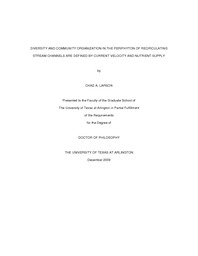
ATTENTION: The works hosted here are being migrated to a new repository that will consolidate resources, improve discoverability, and better show UTA's research impact on the global community. We will update authors as the migration progresses. Please see MavMatrix for more information.
Show simple item record
| dc.contributor.author | Larson, Chad A. | en_US |
| dc.date.accessioned | 2010-03-03T23:30:27Z | |
| dc.date.available | 2010-03-03T23:30:27Z | |
| dc.date.issued | 2010-03-03T23:30:27Z | |
| dc.date.submitted | January 2009 | en_US |
| dc.identifier.other | DISS-10404 | en_US |
| dc.identifier.uri | http://hdl.handle.net/10106/1997 | |
| dc.description.abstract | In a series of experiments taking place in recirculating artificial stream channels, periphyton communities growing on ceramic tiles were subjected to variations in current velocity and nutrient supply. The first experiment used stream water and manipulated current velocity, subjecting periphyton communities to either high or low current velocities (30 and 10 cm * sec-1 respectively), while in experiments 2-4, modified WC media was used and periphyton communities subjected to different nutrient (low and high) and current regimes (low, high, and variable flow). Each experimental run lasted 35 days. In all experiments, greater species richness of periphyton communities was observed in the low current velocity treatments. In experiments 2-4, greater species richness was observed under conditions of high nutrient supply. Species richness and evenness also responded to changes in several structural properties of the biofilm matrix, most notably biofilm heterogeneity and thickness. The relationship between species richness and productivity, as measured with community biovolume, displayed several trends, ranging from no relationship to unimodal, depending on experimental treatment. Multivariate analyses of periphyton communities revealed that in the experiment manipulating current velocity, communities in the two current treatments exhibited convergence, displaying greater similarity with time, while in the experiments manipulating current velocity and nutrient supply, periphyton communities exhibited divergence between nutrient treatments, displaying greater dissimilarity with time. Additionally, algal guilds responded to variations in nutrients, with greater guild diversity observed under conditions of high nutrient supply. Under conditions of high nutrients, diatom communities were dominated by `eutrophic-motile' species, while `non-eutrophic-adnate' species were dominant under conditions of low nutrients. These results suggest that current velocity and nutrient supply are important factors influencing periphyton communities and that community assembly is influenced by a combination of deterministic and stochastic factors. | en_US |
| dc.description.sponsorship | Passy, Sophia | en_US |
| dc.language.iso | EN | en_US |
| dc.publisher | Biology | en_US |
| dc.title | Diversity And Community Organization In The Periphyton Of Recirculating Streams Channels Are Defined By Current Velocity And Nutrient Supply | en_US |
| dc.type | Ph.D. | en_US |
| dc.contributor.committeeChair | Passy, Sophia | en_US |
| dc.degree.department | Biology | en_US |
| dc.degree.discipline | Biology | en_US |
| dc.degree.grantor | University of Texas at Arlington | en_US |
| dc.degree.level | doctoral | en_US |
| dc.degree.name | Ph.D. | en_US |
| dc.identifier.externalLink | https://www.uta.edu/ra/real/editprofile.php?onlyview=1&pid=93 | |
| dc.identifier.externalLinkDescription | Link to Research Profiles | |
Files in this item
- Name:
- Larson_uta_2502D_10404.pdf
- Size:
- 1.328Mb
- Format:
- PDF
This item appears in the following Collection(s)
Show simple item record


